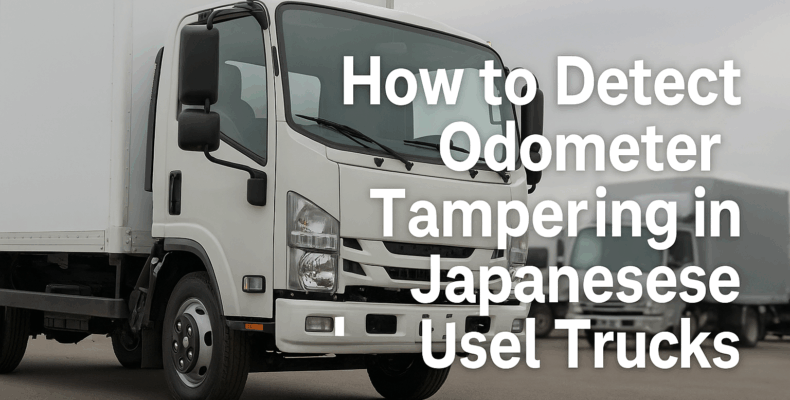When buying a Japanese used truck, mileage plays a big role in the price. Naturally, lower mileage often means better condition and longer life. However, this creates opportunities for dishonest sellers to commit odometer fraud.
Tampering with the mileage—also called “clocking”—can lead to surprise repairs, higher costs, and even legal trouble. But don’t worry. With the right knowledge, you can easily detect signs of manipulation and make smarter import decisions.
Let’s explore how odometer tampering happens, how to spot it, and what you can do to protect yourself.
🔧 What Is Odometer Tampering?
Odometer tampering involves resetting, rolling back, or replacing a truck’s odometer to show fewer kilometers than the vehicle has actually traveled.
This makes the truck appear more valuable than it is. Unfortunately, some unethical dealers or exporters do this to trick buyers—especially those located overseas who can’t inspect the truck in person.
✅ Common Warning Signs of Tampered Odometers
1. Unusual Wear and Tear for the Mileage
If the truck claims 60,000 km but the steering wheel, gear knob, or pedals are heavily worn, that’s a red flag.
-
Cracked seats or faded dash = high use
-
Rust or paint fading = years of outdoor exposure
-
Check door handles and switches for excessive wear
These physical signs often tell the truth.
2. Mismatch Between Auction Sheet and Odometer
Japanese auction sheets include verified mileage (実走行). If this doesn’t match the current odometer reading, something may be wrong.
-
Look for “改ざん” which means “tampered”
-
“不明” means unknown mileage
-
Always request a scan of the original auction sheet
Transition tip: Even if the truck looks clean, always compare auction data with actual readings.
3. Missing Service History or JEVIC Certificate
Reputable exporters provide maintenance records or a JEVIC mileage verification certificate.
If they can’t show any documentation, ask why.
-
JEVIC verifies actual mileage at the time of export
-
Records from Japanese dealerships also confirm mileage trends
No proof? That’s a reason to walk away.
4. Suspicious Pricing
If a truck has surprisingly low mileage for its year—but is priced lower than others—be cautious.
-
A 2013 model with only 30,000 km shouldn’t be cheaper than a similar one with 100,000 km
-
Low price + low mileage = potential scam
Ask for an explanation and documents before sending payment.
5. Odometer Type: Mechanical vs Digital
Mechanical odometers are easier to roll back than digital ones.
-
Trucks from the early 2000s often use analog dials
-
Modern models have digital LCD screens, which are harder to tamper with but still not foolproof
If it’s mechanical, inspect the numbers closely—misaligned digits may suggest tampering.
🧭 How to Protect Yourself When Importing
✅ Work Only with Trusted Exporters
Don’t risk buying from unknown dealers with no verifiable track record.
👉 Start with this trusted list:
Top 5 Trusted Japanese Used Truck Exporters for Global Buyers
These companies offer auction sheet copies, inspection photos, and third-party verifications.
✅ Ask for Documentation
Request:
-
The auction inspection sheet
-
The export certificate
-
A JEVIC certificate, if available
-
Photos of the odometer reading and interior
Good exporters share all these without hesitation.
✅ Cross-Check VIN and Export Data
Use the chassis number (also called the VIN) to verify the truck’s history online.
Some exporters have database access to past mileage records. Ask them to provide mileage history if you’re unsure.
🌍 Why This Is Especially Important for Overseas Buyers
If you’re importing a truck to Africa, the Middle East, Southeast Asia, or South America, in-person inspection is hard. You depend on exporters to be honest.
That’s why spotting odometer fraud is critical. It protects your business, your finances, and your peace of mind.
✅ Final Thoughts
Odometer tampering can fool even experienced buyers. However, by checking the auction sheet, asking the right questions, and working with trusted exporters, you can avoid this common trap.
Stay sharp. Choose wisely. Import with confidence.
